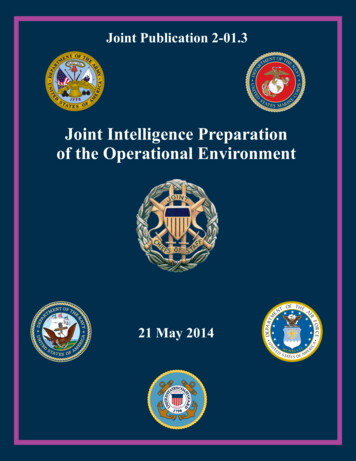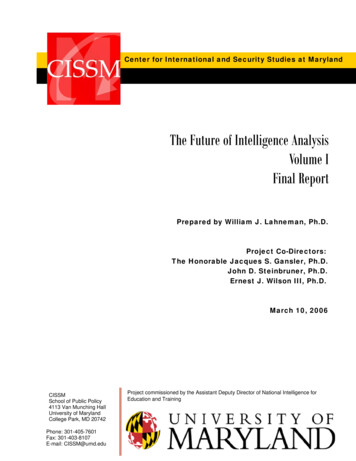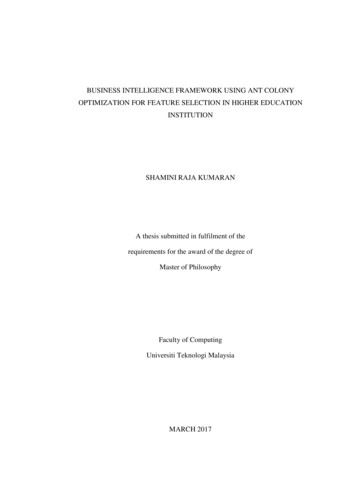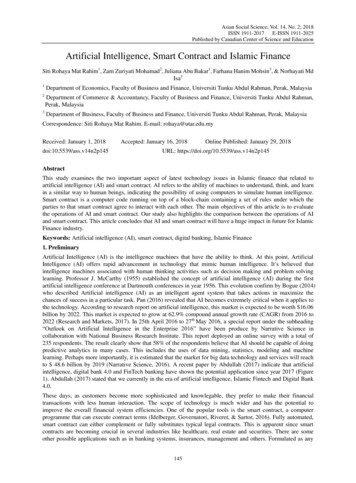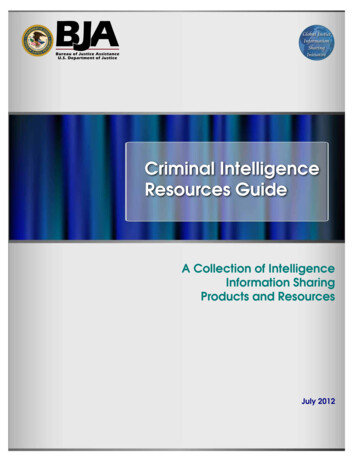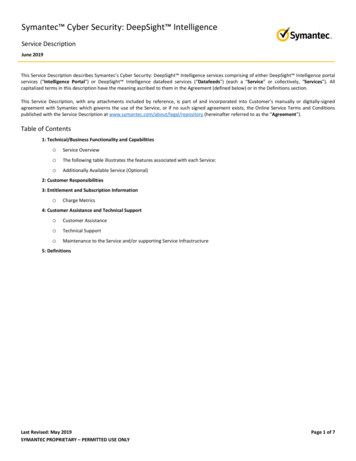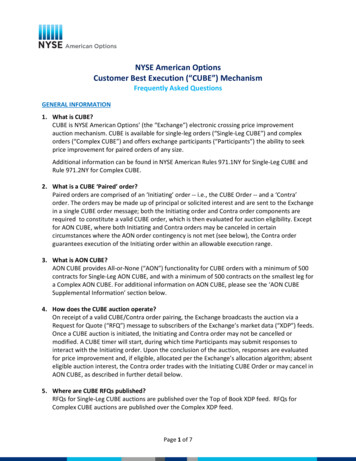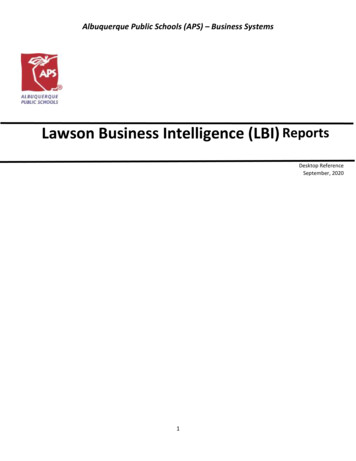
Transcription
Complex IntelligencePreparation of theBattlefield in UkrainianAntiterrorism OperationsVictor R. MorrisThe U.S. Army Europe Joint MultinationalReadiness Center’s Raptor 14 team supported“Battle Staff Attack the Network/NetworkEngagement and Company Intelligence Support Team”training for Ukrainian armed forces officers conducting antiterrorism operations September 2015 at theInternational Peacekeeping and Security Center (IPSC)in Yavoriv, Ukraine. The training team determinedtraditional doctrinal tools for intelligence preparation were inadequate to help Ukrainian intelligencestaffs understand their operational environment (OE).Consequently, the team adapted the process in a waythat would account forVictor R. Morris is angroup dynamics andirregular warfare andhow they influence thecounter-IED instructorbehavior of populationsat the Joint Multinationalrelevant to the OE, conReadiness Center insistent with a conceptGermany. He has conductcalled complex intellied partnered training ingence preparation of thesixteen European nationsbattlefield, or complexto include Ukraine, withIPB. This experiencefour NATO centers of exserves as a case studycellence, and at the NATOon how cross-functionJoint Warfare Center. Aal staffs and companycivilian contractor andcommand teams canformer U.S. Army officer,improve problem framhe has experience in bothing, understand relecapacities in Iraq andvant issues at all levels,Afghanistan.and inform operational58planning. Complex IPB can support the Army’s doctrinal intelligence preparation of the battlefield process andthe joint process called joint intelligence preparation of theoperational environment (JIPOE).From IPB to Complex IPBAccording to Army Techniques Publication2-01.3, Intelligence Preparation of the Battlefield, anArmy intelligence staff (1) defines the OE, (2) describes environmental effects on operations, (3) evaluates the threat, and (4) determines the threat.1 Thestaff uses this four-step process to analyze certainmission variables in the area of interest for a specificoperation.2 The mission variables analyzed are theenemy, terrain, weather, and civil considerations.3 Thegoal of Army IPB is to provide Army commandersand staffs the information necessary to develop courses of action and make decisions.4The IPB doctrine states that all four of the mission variables—including civil considerations—andtheir interactions must be analyzed if the process is tobe effective. Staffs must “determine how the interactions of friendly forces, enemy forces, and indigenouspopulations affect each other.”5 However, in practice,the process tends to emphasize the enemy ratherthan holistically integrate the civil considerations. Forinstance, staffs might not adequately consider multigroup interconnectedness, micro decision making,and population behavior evaluation (i.e., human-domain-centric analysis). Thus, if an OE and its dynamicsJanuary-February 2017MILITARY REVIEW
COMPLEX IPBare like a garden, the IPB process described in Army(and Marine Corps) doctrine focuses intelligenceanalysts on the soil, weeds, and insects, instead of theentire landscape and the interactions that made theplants vulnerable or resilient to harm or imbalance.Authors Tom Pike and Eddie Brown explain howcomplex IPB could improve IPB in a March 2016article in Small Wars Journal.6 According to Pike andBrown, “Using IPB as the nucleus and integratingconcepts from complex adaptive systems theorygenerates Complex IPB.”7 Instead of primarily identifying and evaluating the enemy or the threat, thecomplex IPB process helps intelligence staffs analyzemultiple groups and how they interact and collectively behave. Like the hybrid and dynamic threats it wasdeveloped to defeat, complex IPB combines conventional and innovative approaches that emphasize cultural and population factors, perception assessments,and analysis of nonmilitary actors in order to createa more accurate understanding of the OE. Therefore,complex IPB expands the core process to include sociocultural profiling, link and social network analysis,and computational agent-based models. AlthoughMILITARY REVIEWJanuary-February 2017A Ukrainian soldier assigned to 1st Battalion, 80th Airmobile Brigade, looks for simulated enemy activity 14 November 2016 duringan urban operations training exercise taught by soldiers assigned to6th Squadron, 8th Cavalry Regiment, 2nd Infantry Brigade CombatTeam, 3rd Infantry Division, as part of the Joint Multinational Training Group–Ukraine at the International Peacekeeping and SecurityCenter in Yavoriv, Ukraine. (Photo by Sgt. Jacob Holmes, U.S. Army)complex IPB has not been employed widely enoughto validate its effectiveness, it can help staffs developa more comprehensive picture of the OE than candoctrinal IPB alone.According to Pike and Brown, “complex IPB is thenext-generation of IPB [that could] dramaticallyimprove foreign population analysis as well as improve U.S. ability to influence foreign populations.”8The six steps of complex IPB are—1. Define the OE.2. Describe fitness landscape effects.3. Evaluate the major groups.4. Evaluate major groups’ courses of action.5. Assess the groups’ interaction.6. Evaluate population behavior.959
What Pike and Brown call a “fitness landscape”is “a population socio-cultural-political-ecosystem,”a construct that relates to the political, military,economic, social, information, and infrastructure(PMESII) system and subsystem analysis used inJIPOE.10 Complex IPB considers individual capabilities that Pike and Brown call “fitness functions,” suchas profession, education, ethnic group, family connections, and economic need, that influence individuals’decisions in relation to the fitness landscape.11 Usingthese constructs, complex IPB can help staffs understand and take into account how individual decisionsinteract and affect group dynamics.A Holistic Way to Frame anOperational EnvironmentJoint doctrine defines an operational environmentas “a composite of the conditions, circumstances, andinfluences that affect the employment of capabilities and bear on the decisions of the commander.”12Understanding the OE and defining all of its dynamicsare essential to successful intelligence preparation. TheOE construct “encompasses physical areas and factors , the information environment (which includescyberspace),” and interconnected systems that can berepresented by PMESII.13According to Joint Publication (JP) 2-01.3, JointIntelligence Preparation of the Operational Environment,JIPOE consists of four steps intended to ensure jointintelligence staffs include all relevant aspects of an OE intheir analysis: (1) define the OE, (2) describe the impactof the OE, (3) evaluate the adversary and other relevantactors, and (4) determine the course of action for the adversary and other relevant actors.14 The purpose is to helpthe joint force commander predict the adversary’s mostlikely actions using a holistic view of the OE and “integrating a systems perspective and a geospatial perspectivealong with the force-specific IPB perspectives.”15To distinguish IPB from JIPOE, joint doctrinecharacterizes the IPB as requiring “micro-analysis tosupport component command operations,” adding that“JIPOE and IPB analyses support each other whileavoiding a duplication of analytic effort.”16 JP 2-01.3illustrates the focus of JIPOE with a circular illustration that places a “holistic view of the operationalenvironment” at the center.17 However, any OE is multidimensional, whether in Army or joint operations,60and understanding it requires a holistic and tailoredapproach to intelligence preparation. Complex IPBsuggests the need to integrate ways to perform holisticanalysis, similar to the focus of JIPOE. Figure 1 (onpage 61) shows the circular JIPOE process model, withcomplex IPB interpreted similarly.Factors usually regarded as influencing the strategiclevel also affect operational and tactical planning. Forexample, the strategic environment is characterizedby a mixture of complex geopolitics and demographics such as population growth, mixed migrations, andurbanization. The relationship among these dynamicsis particularly complex due to global connectedness andemerging and disruptive technologies. These phenomenahave created an ever-evolving ecosystem of convergingprincipal and hybrid threats such as revanchist states,extremist proto-states (e.g., the Islamic State), collectiveviolent extremist organizations, state supporters, andtransnational organized crime networks.Operations such as foreign internal defense, counterinsurgency, counterterrorism, unconventional warfare, and law enforcement employ a variety of activitiesand collaborative efforts in the processing, exploitation,and dissemination of intelligence relating to the threatgroups and their interactions with relevant populations. All of the aforementioned operations can occurin isolation, or they can be combined with conventional-force offensive, defensive, and stability tasks in Armyor joint operational areas.Complex IPB emphasizes civil considerations,which include population groups and the societal conditions that influence them, when analyzing the OE.The threat and threat supporting groups’ ecosystemencompasses interactions affecting the OE; they employ a variety of capabilities, tactics, and weapons. Theassociated weapons threat can be broken down intothree main categories: conventional weapons, weaponsof mass destruction (WMD), and improvised weapons.Improvised weapons offer the potential to modify andcombine conventional and WMD capabilities throughnonmilitary means of delivery using readily availableand self-manufactured materials and technology,making the use of improvised weapons widespread inirregular warfare. In fact, the use of improvised weapons is widespread in many operational areas, sometimes as modified munitions and weapons, improvisedexplosive devices (IEDs), or improvised chemical orJanuary-February 2017MILITARY REVIEW
COMPLEX IPBStep fourDetermine adversaryand other relevantactor courses of actionDefine the operationalenvironmentStep oneHolisticview of theoperationalenvironmentEvaluate theadversary and otherrelevant actorsStep threeDescribe the impact ofthe operationalenvironmentStep twoJoint intelligence preparation of the operational environment process(Graphic from Joint Publication 2-01.3, Joint Intelligence Preparation of the Operational Environment[Washington, DC: U.S. Government Publishing Office, 21 May 2014], I-25)1. Define theoperationalenvironment6. Evaluatepopulation behaviorHolisticview of theoperationalenvironment5. Assess groupinteractions2. Describe thefitnesslandscapeeffects3. Evaluatemajor groups4. Evaluate majorgroups’ coursesof actionComplex intelligence preparation of the battlefield(Graphic by Victor R. Morris; steps from Tom Pike and Piotr M. Zagorowski, “Dense Urban Areas: TheCase for Complex IPB,” Military Intelligence Professional Bulletin 42, no. 3 [ July-September 2016])Figure 1. Joint Intelligence Preparation of theOperational Environment and Complex IntelligencePreparation of the Battlefield ComparisonMILITARY REVIEWJanuary-February 2017biological weapons. The combinations oftraditional and irregular capabilities thathybrid threats employ are often facilitatedby mutually supporting actors and varyingresources. Additional hybrid threat characteristics involve employing proxy forces andconducting high- and low-intensity battlefield operations (ways and means) to reachpolitical objectives (ends).In a May 2016 article in Army Magazine,Phillip Karber and Joshua Thibeault describe how Russia’s involvement in Ukraineillustrates its “new-generation warfare,”which “combines both low-end, hidden stateinvolvement with high-end, direct, evenbraggadocio superpower involvement.”18According to Karber and Thibeault, Russia’sstrategy includes political subversion, proxysanctuary, intervention, coercive deterrence,and negotiated manipulation.19 To achieve itsaims, Russia’s military efforts include mixedcompany and battalion tactical groups withelectronic warfare, unmanned aircraft systems, massed fires, armor and heavy-infantryfighting vehicles, and air defense capabilities.20 In this environment, complex groupdynamics interact with military operations.Complex Interactionsin UkraineGiven the varied and dynamic natureof the hybrid threat, the demographics,and the motivating factors present in theDonbass region of Ukraine, it is clear that aholistic OE analysis, using complex IPB, isneeded. With regard to Donbass, the fitnesslandscape and functions are somewhatdisconnected from the rest of Ukraine andfrom Russia. This separation has left theseecosystems in a state of artificial regulationand physical isolation, in which both internalseparatists and outside actors manipulate theregion’s fitness landscape. In addition to manipulating these dynamics, both separatistsand outside actors ineffectively attempt toreplicate governance and political structuresthrough elections and appointment of chief61
executives and parliaments within the region usingmilitary and nonmilitary means.While it is true that the region is isolated, it is onlyisolated to a certain extent; events in Donbass have rippleeffects for the populations in that region and also forUkraine as a whole, for neighboring countries, and for therest of Europe and the international community. Theseare the reasons to employ complex IPB, which emphasizes group behavior. Individuals compose a group, andgroups compose populations. Populations are represented by some kind of state, protostate, rogue state, orthird party. What IPB and JIPOE tend to neglect areways to understand how these individuals, populations,and states all interact with one another, as well as howrelatively small interactions can have significant rippleeffects. Complex IPB accommodates this complexityin how it evaluates groups (step 3) and their courses ofaction (step 4). However, assessing what drives theirinteractions (step 5) and how individuals and groupsmake certain decisions or take certain actions (step 6)requires further analysis of the incentives or motivatingfactors—the fitness landscape effects.Incentive structures are the conditions within thefitness landscape, or within the PMESII systems, thaton a macro level promote cooperation or competitionand on a micro level push individuals and groups tomake decisions and perform actions.21 Actions or decisions may be influenced by a central authority figureor made independently by individuals. If many individuals arrive at similar decisions, a bottom-up groupphenomenon manifests. This is evident during colorrevolutions, for instance.In Donbass, some individuals and ethnic groupssupport the separatist movement instead of the government in Kiev. Some of the reasons (i.e., the incentives)individuals support the separatists include a general sense of mistrust toward the central governmentin Kiev, according to political science writer EliseGiuliano’s 2015 study “The Origins of Separatism:Popular Grievances in Donetsk and Luhansk.”22Giuliano reports that a significant minority feel betrayed by the government, which they claim conducted“discriminatory demographic redistribution withinUkraine.”23 Some believe economic policies such aspotential European Union membership will hurt theirinterests, and some are opposed to certain governmentpolicies. Therefore, while some share a sense of political62and economic loyalty to Russia, the incentives leadingindividuals to support the separatists vary. Each groupor individual may have different motives for theirmicrodecision to support separatists’ goals, but themacroresult is considerable support for the separatistmovement. Furthermore, as individuals, groups, andstates interact, microdecisions can change over timeand cause the collective result to shift.Training the UkrainianArmed ForcesDuring the 2015 training in Yavoriv, the trainingteam conducted a process with what amounted to theessential elements of complex IPB, while teaching anintroduction to JIPOE lesson that included PMESIIsystem mapping. The practical exercise was directlyapplied to operations in the Donetsk and Luhanskoblasts in eastern Ukraine in order to understand theseparatist movement—including the effort that wasknown as Projekt Novorossiya.24 Because the focus ofthis course was intelligence preparation together withsystem and hybrid network analysis, and because of thecomplex nature of groups operating inside and outsideof Ukraine, it was both appropriate and effective toutilize complex IPB concepts in this context.The adapted process was more effective than typicalintelligence preparation because it not only identifiedthe threat actors and their behaviors but also went astep further to consider the incentive structures thathelped create those behaviors and the likely effects ofproposed lethal and nonlethal action to support, influence, disrupt, or neutralize targeted behaviors.The exercise began by identifying actors throughadversary evaluation. The usual process was thenexpanded by first producing a description of fitnesslandscape effects, and then a graphical evaluation of themajor groups influencing political policy and militaryoperations in Ukraine. Major groups’ courses of actionand group interactions influencing population behaviorwere also assessed in detail.Next, the exercise performed complex networkmodeling that highlighted the sociocultural factors andelements of national power that drove instability, aswell as fitness landscape effects and specific incentivestructures present. Complex adaptive system emergence characteristics involving decentralized militaryoperations and decision making were also modeled. InJanuary-February 2017MILITARY REVIEW
COMPLEX IPBRussian OrthodoxChurchPresidentPutinOligarchsMass mediaGeneral Staff ofArmed ForcesLogistics convoysMain IntelligenceDirectorate(GRU)Federal SecurityServiceNovorossiya movementOrganized crimeDon KossacksLugansk NationalRepublicSeparatistparamilitary groupsSpecial purposeforcesDiversion andreconnaissance groupsDonetsk NationalRepublicCrimeaSeparatistparamilitary groupsGround forcesRussian FederationSpecial purposeforcesDiversion andreconnaissance groupsPeople andinfrastructure(Graphic by author)Figure 2. Ukraine Hybrid Thread Threat Modelfact, network modeling and understanding of the mutually supporting relationships between the perceivedthreat and threat supporting groups were also developed by the Ukrainian students (see figure 2).As the intensity of warfare fluctuates, so do thethreats and employment of various weapons systems.Therefore, since new technologies are constantly changing and complicating the OE, a more detailed analysisidentified specific adversary capabilities, tactics, andcourses of action. The analysis went a step furtherby considering the effects generated from the manypossible combinations and permutations of overlappingaffiliations that could influence pro-government forces,population behavior, and international assistanceefforts.25 For example, enemy diversion and reconnaissance groups appeared at the lower or tactical end ofthe model and highlighted dispersed interactions. Theywere associated with modified conventional weaponsand IEDs targeting government forces, civilians, andcritical infrastructure. As a note, other capabilitiesMILITARY REVIEWJanuary-February 2017associated with diversion and reconnaissance groupsinvolved artillery correction, marauding, and kidnapping and interrogation. Next, since conventionalartillery had accounted for 85 percent of the casualtieson both sides of the war in Donbass thus far, it wasconsidered a greater threat than modified weapons andmunitions (e.g., mines and grenades) and IEDs duringa conflict that has fluctuated from high to low intensityover a prolonged period.26 Furthermore, the conventional fires warfighting function was enhanced throughlayered, unmanned aircraft system reconnaissance andforward observation. This strategy was then coupledwith preplanned and massed multilaunch rocket systems and cross-border artillery strikes.The exercise and subsequent discussions highlightedshared-understanding requirements. Moreover, theyhighlighted fundamentals for network engagement andintelligence preparation, including analysis of the OE, andof basic (measures of centrality) and group social networks and behavior. While the threat model in figure 263
illustrates sixteen of thevarious groups inside andoutside of the operationalarea, it does not accountfor “friendly, neutral, andunknown” actors andgroups whose decisionsand behaviors affectoperations. These actorsshould also be includedin a holistic analysis forappropriate engagementand effects assessment inorder to produce the mostcomprehensive assessment of the OE.Nevertheless, the participants did assess thatthe effects of the threat’sbehavior and the population’s behavior would be“a stalemate, with neitherthe government northe insurgency gainingground.”27 More refinedanalysis, however, wouldreveal the factors thatwere influencing the mostvulnerable portion of thepopulation who did notfully support the insurgency and felt betrayedand disenfranchised bythe legitimate government in Kiev. Thus, onone hand, future assessments would identify additional, interrelated PMESIIimplications involving military reform, anticorruption,and reconciliation initiatives by the Ukrainian government. On the other hand, continued assessmentswould identify implications of external defense supportand ceasefire special monitoring missions by intergovernmental organizations.Finally, while understanding how nonmilitarygroups influence their OE can help military forcesconduct successful operations, complex IPB assessments also reveal that the problems that lead to conflict64A Ukrainian company commander analyzes threat network associations and interactions during company-level intelligence and countering threat networks training 17 September 2015 at the International Peacekeeping and Security Center in Yavoriv, Ukraine. (Photo byJosh Ryner)cannot be solved by military force alone. Currenthybrid threats and external influences will continue toexploit vulnerabilities and grievances if they are notacknowledged, holistically reconciled, and politicallyaccommodated by the Kiev government. Therefore, theJanuary-February 2017MILITARY REVIEW
COMPLEX IPBissue becomes what national and international instruments of power could be enabled apart from militaryforce in order to restore the Donbass region’s systemsspecifically, and Ukraine’s identity, ecosystem, andpostrevolutionary equilibrium overall.ConclusionThe complex IPB process expands the doctrinalintelligence preparation processes to include bottom-up intelligence refinement and dynamic humannetwork analysis. Therefore, in operational environments characterized by complex demographics andtheir various incentive structures, complex IPB provides a much needed comprehensive analysis—notonly of these system dynamics but also of their interactions and capabilities on varying levels. ComplexIPB, as employed during the Ukrainian forces’ 2015practical exercise, undoubtedly helped the participants achieve a more comprehensive understandingof the OE specifically, and of the antiterrorism operations as a whole.The Ukraine experience with employment ofcomplex IPB suggests the strong potential for achievingsimilar results in other operations, such as antiterrorism operations in Africa. Other potential test cases forthis process could include operations in the Caucasusand Levant regions in complex urban environments,and in megacities. It is crucial that human and groupdynamics fuse with infrastructure and physical environment analysis in order to understand anti-access/area denial hybrid-threat connections and to create themost comprehensive understanding possible of humanbehaviors that affect operations. Slava Ukraini, GeroyamSlava (Glory to Ukraine, Glory to the Heroes)Notes1. Army Techniques Publication (ATP) 2-01.3, IntelligencePreparation of the Battlefield (Washington, DC: U.S. GovernmentPublishing Office [GPO], 2014), 1-2. ATP 2-01.3 also is publishedas Marine Corps Reference Publication 2-3A, Intelligence Preparation of the Battlespace.2. Ibid.3. Ibid., 1-1. A Marine Corps staff analyzes “the threat and theenvironment in a specific geographic area.”4. Ibid., 1-2.5. Ibid.6. Tom Pike and Eddie Brown, “Complex IPB,” Small WarsJournal website, 24 March 2016, accessed 5 December ipb. Pike andBrown’s model shows similarities to Jamison Jo Medby andRussell W. Glenn, Street Smart: Intelligence Preparation of theBattlefield for Urban Operations (Santa Monica, CA: RANDArroyo Center, 2002), accessed 24 October 2016, ph reports/2007/MR1287.pdf.7. Pike and Brown, “Complex IPB.”8. Ibid.9. Ibid.; Tom Pike and Piotr M. Zagorowski, “Dense UrbanAreas: The Case for Complex IPB,” Military Intelligence Professional Bulletin 42, no. 3 ( July-September 2016). Note that in theirMarch 2016 article, Pike and Brown erroneously called the firststep of complex IPB “Define the area of operations,” but in Pikeand Zagorowski’s July-September article, they corrected step oneto read “Define the operational area.” Although published a yearafter the Raptor 14 team’s experience in Ukraine, the concepts inPike and Brown, and in Pike and Zagorowski, eloquently capturethe principles the team used.10. Pike and Brown, “Complex IPB”; Joint Publication( JP) 2-01.3, Joint Intelligence Preparation of the Operational Environment (Washington, DC: U.S. GPO, 21 May 2014), I-1.11. Pike and Brown, “Complex IPB.”MILITARY REVIEWJanuary-February 201712. JP 3-0, Joint Operations (Washington, DC: U.S. GPO,11 August 2011), xv–xvi and GL-14.13. Ibid., xvi.14. JP 2-01.3, Joint Intelligence Preparation, I-1.15. Ibid., I-5.16. Ibid.17. Ibid., fig. I-6, p. I-25.18. Phillip Karber and Joshua Thibeault, “Russia’s New-Generation Warfare,” Army Magazine website, 20 May 2016,accessed 5 December 2016, -generation-warfare.19. Ibid.20. Ibid.21. Michael Armstrong, Armstrong’s Handbook of Reward Management Practice: Improving Performance through Reward, 5th ed.(London: Kogan, 2015), describes ways that incentives influenceindividual decision making, cooperation, and competition.22. Elise Giuliano, “The Origins of Separatism: Popular Grievances in Donetsk and Luhansk,” PONARS Eurasia Policy MemoNo. 396, October 2015, accessed 24 October 2016, olicy-memos-pdf/Pepm396Giuliano Oct2015 0.pdf.23. Ibid., 2.24. A Ukrainian officer described Projekt Novorossiya as consisting of seven territories and involving the notion that Ukraine is notsovereign and historically belongs to Russia. Novorossiya plans cameto fruition first with Crimea and then by the Donetsk and Luganskoblasts. The overall goal of the project was to unite Kharkiv, Lugansk,Donestsk, Zaporizhia, Mikolaiv, and Odessa with Transnistria andisolate Ukraine from the Black Sea. Projekt Novorossiya is considereddefunct due to lack of popular support.25. In “Complex IPB,” Pike and Brown discuss the potentialcalculations for the possible effects of different groups.26. Karber and Thibeault, “Russia’s New-Generation Warfare.”27. Pike and Brown, “Complex IPB.”65
Antiterrorism Operations Victor R. Morris T he U.S. Army Europe Joint Multinational Readiness Center's Raptor 14 team supported "Battle Staff Attack the Network/Network Engagement and Company Intelligence Support Team" training for Ukrainian armed forces officers conduct-ing antiterrorism operations September 2015 at the



